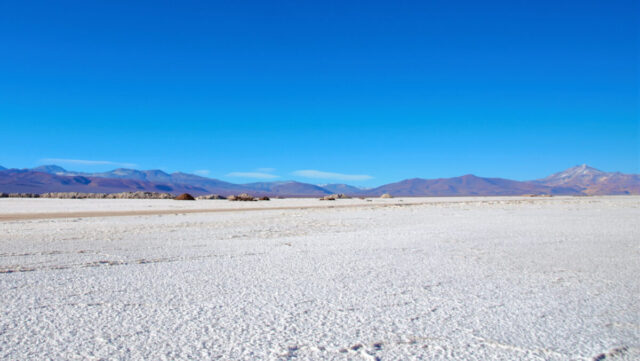- The lithium M&A craze gripping the West Australian market has flown to Chile, where state copper company Codelco is eyeing a deal with ASX-listed Lithium Power International
- LPI grants due diligence as Codelco eyeballs its Maricunga brine project
- Shareholder Nero Resource Fund’s Rusty Delroy says Codelco consolidation play is a logical move
Yet more lithium M&A took centre stage on the ASX yesterday leaving one to question when the cascade will stop.
As Gina Rinehart appeared to snare yet another parcel of Liontown (ASX:LTR) shares in a Euroz Hartleys trade, building an even bigger blocking stake to Albemarle’s proposed $6.6 billion takeover of the WA developer, and MinRes (ASX:MIN) secured the thumbs up from WA’s Supreme Court for its acquisition of the Bald Hill lithium mine, copper giant Codelco was revealed to be in talks for a deal with ASX minnow Lithium Power International (ASX:LPI).
LPI surged 35% yesterday to 35c a pop, closing the day with a market cap of $220 million as investors dreamed of a payday from the state-owned copper producer, which challenges America’s Freeport McMoran for the status as the world’s largest producer of that metal.
Lithium Power owns the Maricunga brine project in Chile, which a study in early 2022 suggested would produce 15,200t of lithium carbonate a year for two decades at a development cost of a touch under $1 billion.
But the goalposts have moved significantly since it hit a five-year high of 91c on April 1 last year (not an April Fools’ joke btw).
Chile produces around a quarter of the world’s lithium from salty brines on the Atacama salar in the legendary ‘Lithium Triangle’ that captures northern Chile and Argentina and non-producing Bolivia, all from concessions privately owned by the world’s two biggest lithium producers — New York-listed Albemarle and SQM.
But it has lost market share in recent years to WA and Argentina, and Chile’s left-leaning government wants to bring that back and capture more of the value for the state.
A new lithium mining policy in Chile announced in April raised concerns that companies not already producing under long term agreements would struggle developing new brine assets without state involvement.
LPI and Codelco a sensible deal: Shareholder
LPI has furnished multiple legal opinions on the status of its pre-1979 Maricunga concessions to argue why it remains in line to develop the project.
But yesterday’s news it had granted due diligence to Corporacion National del Cobre, Chile (aka Codelco), suggested another small player could be hoovered up a major lithium with its EV-powered future hits the bigtime.
Nero Resource Fund founder and investment manager Rusty Delroy is supportive of a deal that captures value for shareholders.
The Cottesloe fund holds around 3.65% of the South American explorer.
“I’d say a holistic transaction as opposed to a joint venture, I think would be in the best interests of Codelco, the government and shareholders,” he said.
“I think the asset’s worth many multiples of where it trades, but do I expect us to achieve an outcome that looks like that? Probably not given the circumstances. I think Codelco will want a good deal.
“All the analysis suggests the asset – I think it’s worth well north of a dollar a share, but do I think I’m going to get $1 a share on a first bid from a party that’s played pretty hardball.
“I doubt that at this stage (but) I hope so.”
Earlier this year LPI simplified its business by, among other things, selling its WA lithium assets surrounding the Greenbushes mine to that project’s 49% owner Albemarle for $30 million.
Delroy said the sale of LPI and its Maricunga project made sense given Codelco’s control of concessions surrounding the asset.
“Our view is that if there was a transaction to occur with Codelco that would be the best place to achieve that objective, because Codelco hold a lot of the rights around LPI’s tenure and if you were to integrate a development, it would be a better scale and most likely better economic development,” he said.
“And I think the government would really like to see a good news story in the lithium space with developments outside of SQM and Albemarle given their recent efforts to update the lithium policy in country.”
More of the same to come?
The sudden surge in lithium M&A and entry of establishment players like Rio Tinto (ASX:RIO) and Gina Rinehart’s Hancock Prospecting into the previously niche space has raised questions around what the industry will look like in the years to come.
Are we heading for an iron ore situation, where a handful of giants have their foot on the neck of the market.
Or will there be enough wrinkles in the landscape for juniors to settle and find a home?
Delroy says companies with larger market caps than LPI have a way to pull back before they become targets, and doesn’t see “much risk” of the lithium supply side getting concentrated into a handful of big players.
“There is a large spread of assets now globally and we expect exploration expenditure will continue to delineate more so I think there isn’t much of a probability of supply re-concentrating as there are simply too many assets to try to control,” he said.
“I don’t think we appreciate too well what has been happening with assets progressing in jurisdictions such as Africa and Brazil and even within China. They are coming too.”
While consolidation will likely continue, he says acquirers could become more ‘price sensitive’ against the massive premiums recently offered in WA.
“I’m not sure some of the WA asset prices out there represent ‘value’ at this stage but time will tell,” he said.
“Our best guess is that equity valuations probably could and should come down a bit in line with current lithium prices pulling back and if that occurs this may precipitate further M&A.”
Lithium Power International (ASX:LPI) share price today
The views, information, or opinions expressed in the interviews in this article are solely those of the interviewees and do not represent the views of Stockhead. Stockhead does not provide, endorse or otherwise assume responsibility for any financial product advice contained in this article.
You might be interested in












